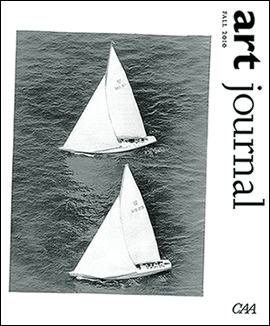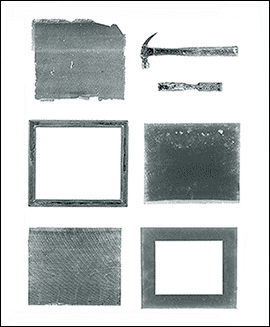
This is the first issue of Art Journal published in 2011, CAA’s Centennial year. We will mark the occasion throughout the year, helped by scholars and artists and a grant from the Andy Warhol Foundation. Our website launched in February, in response to the changing nature of art writing and publishing, and to the wish to attend to time-based and new media art. Some content is linked to the print version of Art Journal: the website presents videos related to Ken Allan’s essay on Wallace Berman, as well as a commissioned project by Paul Chan, who contributed to the current issue. The site also features web-only art and scholarship, such as a never-before-published interview with David Wojnarowicz.
In the print issue, we will mark the Centennial with a special cluster of features on print itself, its history and future with respect to both the art medium and the dissemination of images and text; that will appear at the end of this year. We have also commissioned a series of artists’ projects and essays, including surveys of several fields within the discipline. In the current issue, a sweeping essay by Richard Shiff addresses broad issues of modern and contemporary art, including the roles of theory and of the individual.
Shiff is primarily interested in unfigured sensory experience and the impulse —the social imperative—to order that experience. Even “theory” failed to break this habit; the very thing that was supposed to unsettle authority became a set of obligatory references, intellectual generalizations, and foregone conclusions. In contrast, the making and viewing of art tolerate as-yet-unnamed sensations and individuals as more than social symptoms; we often value art for precisely this reason. Saloni Mathur describes the competing pressures of modernism, American art institutions, and the state in postcolonial India, amid which Ray and Charles Eames’ appreciation of traditional Indian objects resonates as a moment of genuine openness. Ken Allan convincingly argues that Wallace Berman’s provisional art, made in response to the mutual desires of a tightly-knit community of artists, rhymed the ethos of Los Angeles jazz. Karen Kurczynski’s essay frames drawing as a medium whose qualities of personal expression and immediacy risk being turned into a saleable, static product.

In light of these traditional and still-compelling arguments against ordering and generalizing, against settling on final forms, it is instructive to read a counterpoint. Christopher Bedford’s forum questions the term “project” as it has become common usage in contemporary art-speak and institutions (including this magazine). The respondents offer a range of hypotheses; most positively, the placeholder provides institutional shelter to artists before their ideas coalesce into clear “outcomes.” More darkly, several participants suggest that “project” belongs to the neoliberal vocabulary of a service economy. Seen in this light, it masks the diffusion of individual autonomy, touting flexibility, and describes a disregard for disciplinary physicality and history against an antiquarian past of specific material production. Debates over this seeming shift trouble and figure much contemporary writing on art.
This is my first issue as editor without the work of Kerry James Marshall, and I would like to thank him once more for his fantastic and generous work on the serial for Art Journal last year, and also to thank and welcome Paul Sietsema, who created the covers for this issue.
